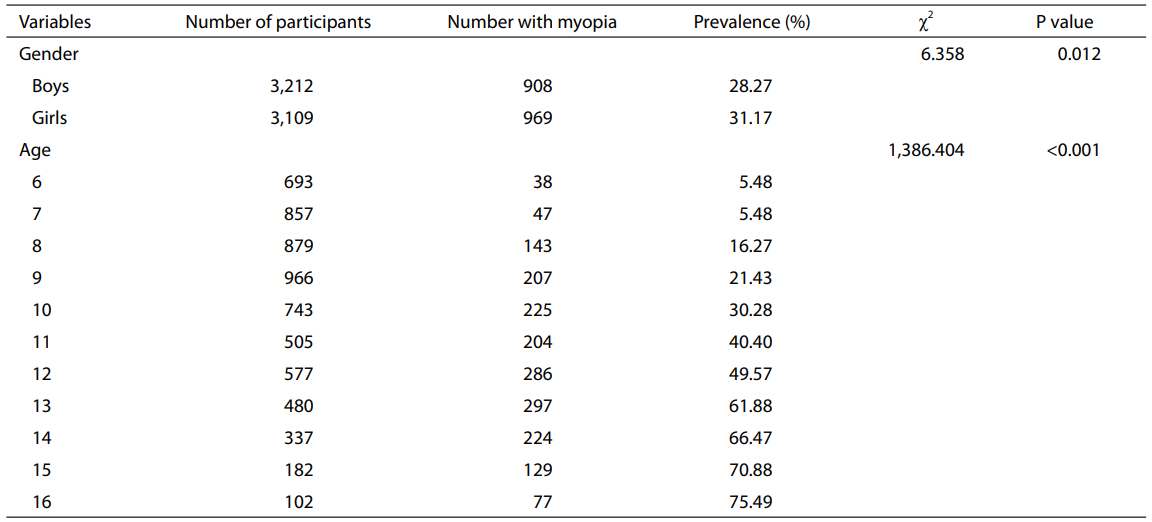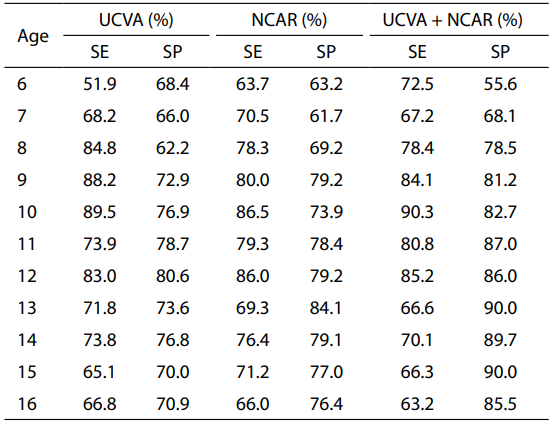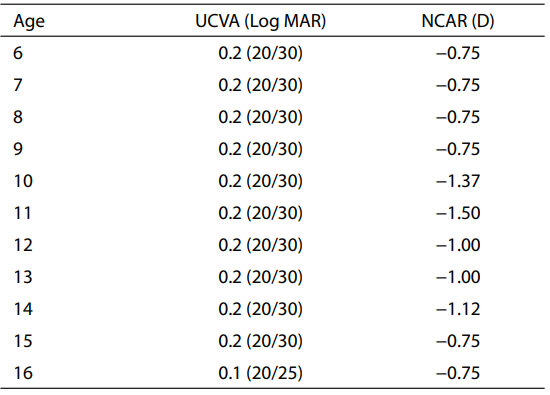General information
Totally, 5,220 primary school children (aged between 6
and 12) and 1,101 junior middle school children (aged
between 13 and 16) were recruited, including 3,212 boys
and 3,109 girls, which accounted for 50.81% and 49.19%
of all, respectively. After cycloplegic refraction, which was
considered as golden standard for diagnosing myopia, 1,876
of 6,321 (29.68%) children were diagnosed as myopia.
There was significant difference in prevalence of myopia
between boys and girls (
χ2 =6.358,
P=0.012). Compared with
children of low age, the prevalence of older children was
significantly higher (
χ2 =1,386.404,
P<0.001). The detailed
information of all children was presented in Table 1.
Table 1 General characteristics of the 6,321 participants
Comparison of accuracy of different screening tests
For all children, the general best cutoff point for UCVA was less than or equal to 0.2 logarithm of minimum angle
of resolution (MAR) (20/30), with associated SE and SP of
77.4% and 74.3%, respectively. For NCAR, the general best
cutoff point was SER less than or equal to −0.75 D, with
associated SE and SP of 76.4% and 80.9%, respectively.
After combining these two tests, the general best cutoff
point was UCVA less than or equal to 0.2 logarithm of
MAR and NCAR SER less than or equal to −0.75 D, with
associated SE and SP of 75.0% and 85.0%, respectively.
As shown in Table 2, after stratifi ed by age, the accuracy
was different among ages. For all children aged between
7 and 16, the combination of UCVA and NCAR achieved
higher SPs and similar SEs compared with these two tests
alone. For children aged 6, the SP of the combination
measure was 55.6%, which was lower than that of either
of the two tests (68.4% and 63.2%, respectively), but the
SE was much higher. Both SEs and SPs were over 80%
for children aged between 9 and 12, which were relatively
higher than those of other ages.
Table 2 Comparison of accuracy of diff erent screening tests for
children of all ages
UCVA, uncorrected visual acuity; NCAR, noncycloplegic
autorefraction; SE, sensitivity; SP, specifi city.
Best cutoff points of combination measure for all ages
Table 3 offered the best cutoff points of the combination
measure for all ages. For children aged from 6 to 9 and
15, the best cutoff point was UCVA less than or equal
to 0.2 logarithm of MAR and NCAR SER less than or
equal to −0.75 D, which was the same with the general
best cutoff point. For children aged between 12 and 13,
the best cutoff point was UCVA less than or equal to
0.2 logarithm of MAR and NCAR SER less than or equal
to −1.00 D. The best cutoff points for other ages were
different from each other. For children aged 10, 11 and
14, the best cutoff points were UCVA less than or equal
to 0.2 logarithm of MAR and NCAR SER less than or
equal to −1.37 D, −1.50 D and −1.12 D, respectively. For
those aged 16, the best cutoff point was UCVA less than
or equal to 0.1 logarithm of MAR (20/25) and NCAR SER
less than or equal to −0.75 D.
Table 3 The best cutoff points of combination measure for
children of all ages
UCVA, uncorrected visual acuity; MAR, minimum angle
of resolution; NCAR, noncycloplegic autorefraction; D,
diopters.
Discussion
More and more attention was paid to myopia of children
due to the high incidence and its increasing tendency(1,6-9,11,12). Some potential associations between myopia
and major age-related eye diseases were reported, such as
nuclear cataract, posterior subcapsular cataract and primary
open-angle glaucoma(13). So it is critical to detect children
with true myopia or with high risk of myopia in early age
accurately, which would lead to an early treatment and help
to relieve the long-term damage. However, the result of
UCVA was subject to be affected by environmental factors,
such as light intensity and reminding from people around
in reality, and often could not detect those with myopia
accurately, which means quite a few of missed diagnosis.
Cycloplegic refraction with retinoscopy and subjective refraction were usually used in most of professional
hospitals, but cycloplegic refraction with retinoscopy needs
high professional skills and rich experience, while subjective
refraction without cycloplegia is not accurate enough for
children, so both of these two methods are not suitable to
be used during large-scale screening. By contrast, NCAR
test is more objective, therefore, it is necessary to combine
NCAR test in order to increase the accuracy of myopia
screening(14-16). For controlling and even lowering the
incidence of myopia, a program on establishing individual
archives of ocular refractive development of children, which
was included in the agenda of local government to enhance
the public health system, was launched in Jiading District
in 2011 and completed at the end of 2013. According to
our study on this program, the SP of UCVA combined with
NCAR was 85.0%, which was much higher than that of the
two tests alone. Meanwhile, the SE of the combination kept
similar to that of UCVA and NCAR alone. In other words,
the combination measure achieved an increased accuracy,
which was in accordance with some researches before(10,17,18). Furthermore, our population-based study had a
larger sample size, which promised a reliable result.
In addition, the accuracy for children aged between
9 and 12 was relatively higher than that of other ages,
indicating that the combination was more practical for
children in this age group. The accuracy for those aged
6 and 7 was much lower than that for other ages, due
to the stronger refraction adjustment ability and poor
cooperation of younger children(19). Furthermore, we
explored that the best cutoff points were age dependent
for the measure of UCVA combined with NCAR. For
children aged from 6 to 9 and 15, the best cutoff points
were the same. Similarly, children aged 12 and 13 also
shared the same best cutoff point. For other ages, the
best cutoff points varied. With the progress of dynamic
monitoring of children refractive development in the
future, we would further examine the criteria and the
associated accuracy for myopia screening. To find the
risk factors of myopia and deliver targeted intervention
after vision screening is important, some researches have
reported the potential risk factors, such as lack of outdoor
activities, heavy homework, wrong posture of reading
and writing, long-time playing electronic products, and
so on(8,9). In the following study, we would explore the
myopia-related risk factors and feasible intervention based
on the dynamic screening.
In conclusion, with an increased accuracy, the
combination of UCVA and NCAR was more feasible to
apply in large-scale myopia screening. The referral criteria
of myopia for primary and junior middle school children
should be age-determined.





